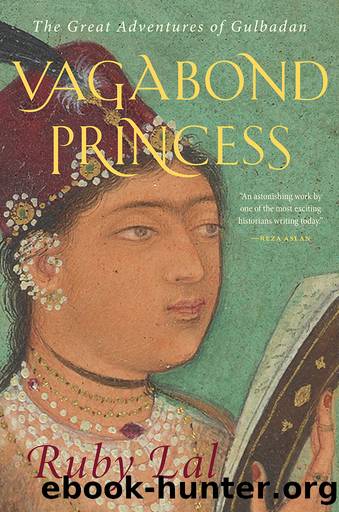Vagabond Princess by Ruby Lal

Author:Ruby Lal
Language: eng
Format: epub
Publisher: Yale University Press
Published: 2023-02-15T00:00:00+00:00
Ten
The Road to Mecca
SEATED UPON A TENT-SHAPED PALANQUIN, ITS SILKEN COVER held firmly with clasps of gold and silver, Gulbadan was primed to take the road to Mecca. Brocade and soft linen textiles from India were spread on the single hump of her brownish-yellow dromedary, also called the Arabian camel, an elegant being with black eyes, a long body, and long hair on its neck. A red steering cord was fastened around its mouth.1
Gulbadan was dressed in her classic flowing attire and a finely stitched muslin stole. A pearl- and cornelian-embedded gold necklace graced her neck. When the day got hot, she could wrap her face with the soft muslin. Similarly dressed, Salima and other women would ride upon their finely decorated Arabian camels.
As royal guests, it was expected that the Mughal women would ride the mamiyya, the best dromedaries with excellent pacing, so smooth that âone could easily go to sleep while riding such beasts.â2 For the distinguished aunt of the Great Mughal of India, it is also certain that the special laissez-passerâcalled yol emri in Ottoman Turkishâwas arranged. The document was an important part of Ottoman practice in easing the travel of eminent guests and ensuring that no interruption took place. Local jurists and provincial governors had instructions to provide escorts and local guides along the dangerous stretches. The governor of Jeddah, a major regional Ottoman appointee, would enable the arrangements for the Mughal convoy.3
Mughal court historian Nizam al-Din Ahmad says that Gulbadanâs kafila, or cavalcade, was patterned after the style and order of the legendary Egyptian and Syrian desert caravans.4 The Egyptians went from Cairo to Mecca via Ajrud and Aqaba, then south along the eastern shore of the Red Sea. They usually took between forty-five and fifty days to reach their hajj destination, making lengthy stops along the way. The Damascus caravan took the same time, although its route was through the desert forts such as Hasa, Tabuk, and al-Rahba, used for stopovers.5
The logistics of a mixed land and sea convoy with a âmultitude of people,â as an imperial Ottoman document remarked about the Mughal procession, were of a different nature.6 Gulbadan had in the first leg of her journey covered approximately eight hundred miles between Fatehpur-Sikri and Surat. After spending nearly a year in Surat before securing the cartaz from the Portuguese, the group had sailed across the Arabian Sea for nearly four weeks before reaching Jeddah. Now that they were on the desert road to Mecca, it was possible to emulate the Egyptian and Syrian desert processions.
Members of the Mughal convoy assembled in designated places before exiting Jeddah from the Mecca Gate. In the Egyptian and Damascene caravans, the hajj commanderâs secretary was in charge of important decisions on the road, such as paying subsidies to Bedouin leaders to ensure their safety. Thieves and poor Bedouins with meager resources lurked around the ancient shrines along the Arabian roads. Attacks on caravans during the forty-mile route between Jeddah and Mecca, which typically took two to three days, were possible.
Download
This site does not store any files on its server. We only index and link to content provided by other sites. Please contact the content providers to delete copyright contents if any and email us, we'll remove relevant links or contents immediately.
| Civilization & Culture | Expeditions & Discoveries |
| Jewish | Maritime History & Piracy |
| Religious | Slavery & Emancipation |
| Women in History |
Cecilia; Or, Memoirs of an Heiress — Volume 1 by Fanny Burney(31339)
Cecilia; Or, Memoirs of an Heiress — Volume 3 by Fanny Burney(30936)
Cecilia; Or, Memoirs of an Heiress — Volume 2 by Fanny Burney(30892)
The Secret History by Donna Tartt(16635)
Sapiens: A Brief History of Humankind by Yuval Noah Harari(13061)
Leonardo da Vinci by Walter Isaacson(11907)
The Radium Girls by Kate Moore(10910)
Sapiens by Yuval Noah Harari(4542)
The Wind in My Hair by Masih Alinejad(4426)
How Democracies Die by Steven Levitsky & Daniel Ziblatt(4401)
Homo Deus: A Brief History of Tomorrow by Yuval Noah Harari(4282)
Endurance: Shackleton's Incredible Voyage by Alfred Lansing(3847)
The Silk Roads by Peter Frankopan(3764)
Man's Search for Meaning by Viktor Frankl(3637)
Millionaire: The Philanderer, Gambler, and Duelist Who Invented Modern Finance by Janet Gleeson(3573)
The Rape of Nanking by Iris Chang(3518)
Hitler in Los Angeles by Steven J. Ross(3440)
The Motorcycle Diaries by Ernesto Che Guevara(3338)
Joan of Arc by Mary Gordon(3260)
